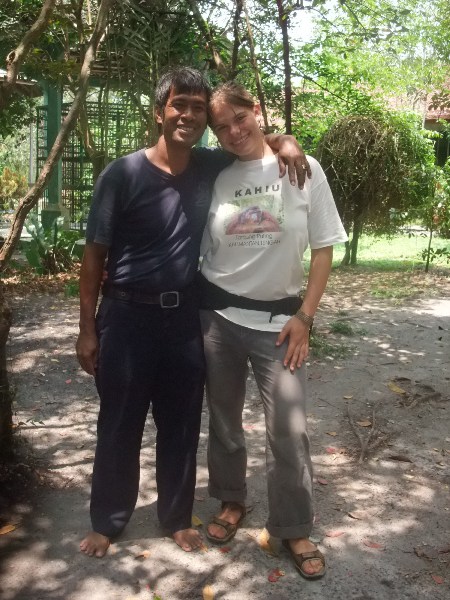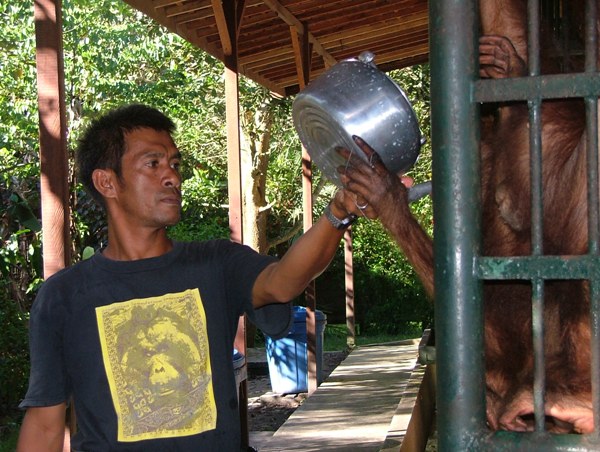Pak Sia giving afternoon milk to some of his charges. Photo by Janie Dubman.
At nineteen years old, young Sia defied his father’s wishes and began a job which he had wanted since elementary school.
.
When Sia was 10 years old, Dr. Birute Mary Galdikas was already hiring Dayaks (natives of Borneo) for her Orangutan Research and Conservation Project in his home village of Pasir Panjang. Dr. Galdikas was Louis Leakey’s third primatologist protégée, following the footsteps of Jane Goodall and Dian Fossey in studying wild great apes. The project’s original research site was (and still is) in Camp Leakey, at the heart of Tanjung Putting National Park, southern Central Kalimantan (Indonesian Borneo). Sia started work in 1989, when the ORCP has already established three rehabilitation centres in the national park where orangutans, orphaned by illegal loggers and miners, were being nurtured and trained for return to the wild. It was at one of these Sia started his orangutan career as carer and rehabilitation assistant. That year, there were six young orangutans at Tanjung Harapan Station.
Today, forty-year-old Sia is responsible for over 300 orangutans as Feeding Coordinator of OFI’s Orangutan Care Centre and Quarantine in Pasir Panjang. His tasks of finding fruit and vegetables to feed the apes, balancing the food budget and overseeing the three times a day feeding are no small peanuts. When asked about the challenges of his job, he frowned for a while, clearly trying to find an answer for me, since his initial response of “Oh, I love everything about my job” didn’t satisfy me. Finally he nodded. “It’s very sad for me when we can’t give food to the orangutans on time. They get hungry like us and it isn’t their fault they are in cages, it’s people’s fault, so we are the ones that must feed and help them”.
In his twenty years with OFI Sia has helped orangutans in tanjung harapan as carer, in Camp Leakey as a forest research assistant, in Jakarta as a primate keeper in a zoo, and in the Care centre as all of the above and more. In fact, the father of three (soon to be four) children once proved his dedication when he informed his former wife that if she didn’t like his work with the orangutans (which she resented), she would be the one doing the leaving.
Indonesians are a very clean people. It is not uncommon to wash four times on a hot day. I asked him to recount his first day at work for me and he animatedly described how he bathed once in the morning, and then became progressively covered in the urine and feces of his clinging charges. Smirking I remarked that he must have had some second thoughts by nightfall. He said that he didn’t take a day off for the next three months because he couldn’t bear to hear the babies crying when he tried to leave.
Sitting on a fruit crate across from the Dayak with the deceptively fierce face, I wrap up with asking him what he intends to do next in his life. He replied simply “Nothing. I want to work with orangutans till the day I die”.

Author with Pak Sia (appropriate address for an Indonesia older man). Photo courtesy of Janie Dubman.
Orangutan Foundation International
Earlier article about Galdikas and Camp Leaky
Saving Orangutans in Borneo
(05/24/2006) A look at conservation efforts in Kalimantan, on the island of Borneo. I’m in Tanjung Puting National Park in southern Kalimantan on the island of Borneo. At 400,000 hectares (988,000 acres) Tanjung Puting is the largest protected expanse of coastal tropical heath and peat swamp forest in southeast Asia. It’s also one of the biggest remaining habitats for the critically endangered orangutan, the population of which has been great diminished in recent years due to habitat destruction and poaching. And orangutans have become the focus of a much wider effort to save Borneo’s natural environment. We are headed to Campy Leakey, named for the renowned Kenyan paleontologist Louis Leakey. Here lies the center of the Orangutan Research conservation Project. Established by Birute Mary Galdikas, a preeminent primatologist and founder of the Orangutan Foundation International (OFI), the project seeks to support the conservation and understanding of the orangutan and its rain forest habitat while rehabilitating ex-captive individuals. The Orangutan Research conservation Project is the public face of orangutan conservation in this part of Kalimantan, the Indonesia-controlled part of Borneo. Borneo, the third largest island in the world, was once home to some of the world’s most majestic, and forbidding forests. With swampy coastal areas fringed by mangrove forests and a mountainous interior, much of the terrain was virtually impassable and unexplored. Headhunters ruled the remote parts of the island until a century ago.
